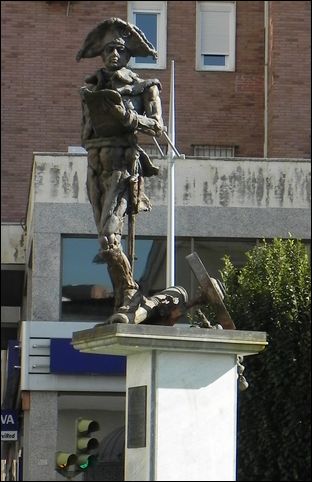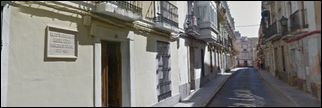MANUEL GODOY
 Manuel Godoy
Manuel Godoy
At the Municipal Board session held on 26 January 1807, the City Council of Badajoz approved, amongst other matters concerning the figure of Manuel Godoy, to erect a bronze and marble statue to honour his memory, which nevertheless would not be made until the year 2008 by Luis Martínez Giraldo.
Godoy was born in Santa Lucía street in Badajoz on 12 May 1767. It is known that although he learnt how to read and write in his own house with the help of the canon Francisco Ortega, he proceded to continue with his higher education at the former seminar of San Atón
He moved to Madrid in 1784 with the purpose of enrolling the Guardias de Corps. Once there, it seems that due to a fall from his horse during the course of an action, the Queen set sight on him and his career followed a sky-rocketing path from then on.
Godoy was received at the State Secretary in 1792 just after the Count of Aranda left office and his governing task was very hard to tackle because of the crucial historical turning point at the time (French Revolution, Napoleonic Wars, confrontation with the United Kindom …)
Spain declared war on France (Rosellón or Convención War), which proved to be a failure ending up with the Basilea Peace Treaty (1795) awarding Godoy the title of Prince of Peace. Afterwards, Spain joined forces with France (San Idelfonso Pact, 1796), which eventually would lead Spain to a new confrontation with the United Kingdom. This war turned out to be a new failure for Spain and caused Godoy´s falling into disgrace (1798). However his removal from governmental responsibilities did not last long, since in 1800 he came back to power again, being appointed President of the Cabinet in 1801, during which term Spain waged with Portugal the so called Oranges War, which was eventually settled with the Badajoz Peace Treaty, whereby Spain took back from the neighbouring country the town of Olivenza and its surrounding villages, establishing the border between the two countries on the line marked by the course of the river Guadiana.
Godoy´s political stance was slowly declining due mainly to his confrontation with Prince Fernando (Fernando Vll in the future). Fernando´s supporters were weaving a black legend web around Godoy, who was held liable for all the evils threatening the country and whose only credit was to have become the Queen´s lover.
Godoy signed a new treaty with France in 1807 (Fontainebleau Treaty), which allowed the French army to march across Spanish territory with the aim of invading Portugal as well as establishing the division of Portugal and providing a share for Godoy himself ( the Algarve Principality ). Nevertheless, once the French army finished the conquest of Portugal, the troops never returned to France but were deployed in some Spanish cities, since Napoleon had decided to break the treaty, take over Spain and overthrow the Borbons.When Godoy became aware of the scheme devised by the French, he tried to prevent new French troops entering the country and ensure the safety of the King and Queen. However, in the face of Godoy´s growing unpopularity at home, the Fernandino Party (King Fernando´s supporters) decided to seize its chance and to deal a final blow that on 17 March 1808 led to the Aranjuez riots, by means of which Godoy was arrested, and deprived of his charges of Supreme Commander-in-Chief and Admiral, his properties also being seized.
Set free by the French, Godoy fled with the Spanish Monarchs to France where they stayed until 1812, when they set off to Rome to settle down there. Finally, in 1832 he moved to Paris, where he died in 1851, having devoted the final years of his life to write his memoirs, partly to justify his governmental policy and partly to get an income to live on.
Godoy was the Badajoz native with the greatest power in the whole history of Spain. Following his fall into disgrace, he was slandered and blamed for almost everything. Nontheless, his human figure and his work are nowadays being recovered and returned to their righteous place. However, it is only fair to mention that although he happened to live through an intricate international situation at a crucial historical turning point, his loyalty to the Monarchs was commendable and his devotion to work was unquestionable. Among other things, suffice it to say that he set up educational institutions and encouraged the development of Primary Education and fostered the building of factories, roads and the development of other types of infrastructure.
Godoy always kept excelent relationships with Badajoz and the city presented him with awards and recognizion.In this respect, it could be worth mentioning that in 1803, when the owners of the present-day Godoy Palace got wind of Godoy´s wish to have a house in Badajoz, they gave up the ownership of the building in favor of the City Council as one of many gifts to come for the city´s ilustrious native. Thus, on account of his appointment as Admiral, the city council arranged a number of public festivities (Municipal Session on 26 January 1807) and ordered to raise a statue in his honour. Later on, when Godoy applied for a plot to build a palace, the city did not hesitate and looked for the best sites for its placement around the citadel as well as the fields surrounding San Francisco and Santo Domingo. In any case, Godoy could never have the chance to enjoy it, since Godoy was driven out of power in March 1807, just two years after the City Council agreed on the construction of the palace in March 1807 and there is no evidence of any of Godoy´s visits to the city during that period of time, as following the Aranjuez mutiny, he was arrested, removed from office and deprived of his titles and properties.


